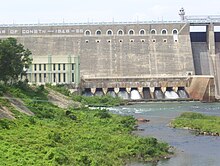| Bhavanisagar Dam | |
|---|---|
 Bhavanisagar Dam and Reservoir | |
| Official name | Keel Bhavani Anai |
| Location | Bhavanisagar, Erode, Tamil Nadu, India |
| Coordinates | 11°28′15″N 77°6′50″E / 11.47083°N 77.11389°E |
| Purpose | irrigation, power |
| Status | open |
| Construction began | 1948 |
| Opening date | 1955 |
| Construction cost | ₹210 million (US$2.4 million) |
| Owner(s) | Government of Tamil Nadu |
| Operator(s) | Government of Tamil Nadu |
| Dam and spillways | |
| Type of dam | earthen |
| Impounds | Bhavani River |
| Height (foundation) | 40 m (130 ft) |
| Height (thalweg) | 120 ft (37 m) |
| Length | 8 km (5.0 mi) |
| Reservoir | |
| Creates | Bhavanisagar Reservoir |
| Total capacity | 32.8×109 cu ft (930×106 m3) |
| Turbines | Lower Bhavani -1 4x2 MW = 8 MW; Lower Bhavani RBC (Right Bank Cannel) = 2x4 MW = 8 MW |
| Installed capacity | 16 MW (21,000 hp) |
| Source[1] | |


Bhavanisagar Dam or Lower Bhavani Dam, is located in Erode district, Tamil Nadu, India.[2] The dam is constructed on the Bhavani river.[1] It is one of the world's largest earthen dams. Thyagi M.A. Eswaran, the Erode MLA was instrumental in bringing the Bhavanisagar Dam Project. M. A. Eswaran, was born to Muthukaruppan Pillai and Venkatalakshmi on 25 October 1895 at Karungalpalayam in Erode. The first major irrigation project executed in Tamil Nadu after Independence, it turned Erode, Tiruppur, and Karur districts into a fertile landscape, irrigating 2,47,247 acres for the cultivation of paddy and other crops, besides generating 18 MW through two power generation houses. M.A.Eswaran was unanimously elected as MLA for Erode area in the Madras Provincial Assembly in 1946. Apart from his contribution to the freedom struggle, he worked for the implementation of the Lower Bhavani Project. Until his death in 22.05.1978, he sacrificed his entire life for the welfare of the people. The dam is situated some 16 km (9.9 mi) west of Sathyamangalam, is 17 km (11 mi) North of Punjai Puliampatti, is 35 km (22 mi) from Gobichettipalayam and is 36 km (22 mi) north-east to Mettupalayam.[3]
- ^ a b "Uniqueness of Bhavanisagar dam" (PDF). CSTI. Retrieved 1 February 2016.
- ^ "Tourist Information for Erode district". Government of Tamil Nadu. Archived from the original on 6 March 2016. Retrieved 1 February 2016.
- ^ "Bhavanisagar dam" (PDF). TNAU. Retrieved 1 February 2016.
